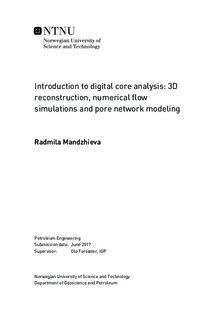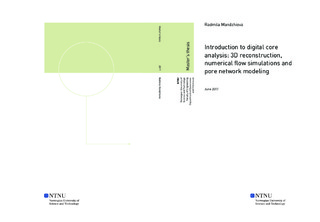| dc.description.abstract | Digital core analysis can replace the use of conventional core samples by decreasing the time required for conducting experiments. Moreover, it gets a better understanding of complex reservoir structures due to its ability to capture pore geometries and fluid behavior at pore scale level.
In the current thesis, the whole workflow of digital core analysis from image study to overlook of pore network models had been performed. It started from analysis of color 2D thin section images. It was noticed that they might contain significant amount of information about pore microstructure. In addition, several different approaches of image binarization were considered.
Then some 3D micro-CT models (incl. four sandstone and one carbonate samples from the open database of the Imperial College London) had been analyzed and reconstructed. To calculate the absolute permeability, a direct pore-scale modeling approach using the lattice Boltzmann method (LBM) was implemented in PALABOS software. It is worth noting that several parameters influenced on the obtained results, for example, the image resolution and the volume of analyzed microstructure. It was found that while using low quality images the permeability by LBM might be significantly overestimated. In addition, to obtain reliable permeability (i.e. close to experimentally measured), the volume should be greater or equal to representative elementary volume (REV). Furthermore, it was possible to compare LBM permeability for reconstructed cases and original models. Results showed the best consistency for medium permeable sandstone samples. However, it had been noticed that reconstruction was not able to produce exactly the same porous media, since several other properties of reconstructed models, e.g. formation factor and specific surface area, were differed from original inputs.
When multiphase flow occurs in porous structures, it is difficult to estimate relative permeabilities directly, since in this case REV should be bigger and LBM calculations are very computationally expensive. That is the reason why the pore network modeling approach was briefly discussed, and several models generated by maximal ball extraction algorithm had been reviewed. | |

